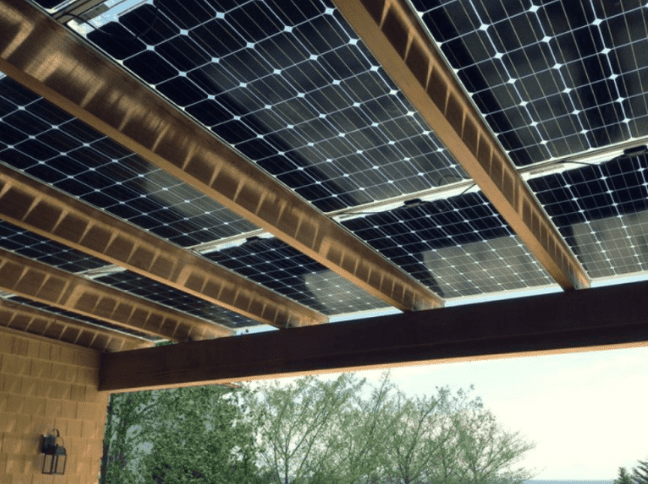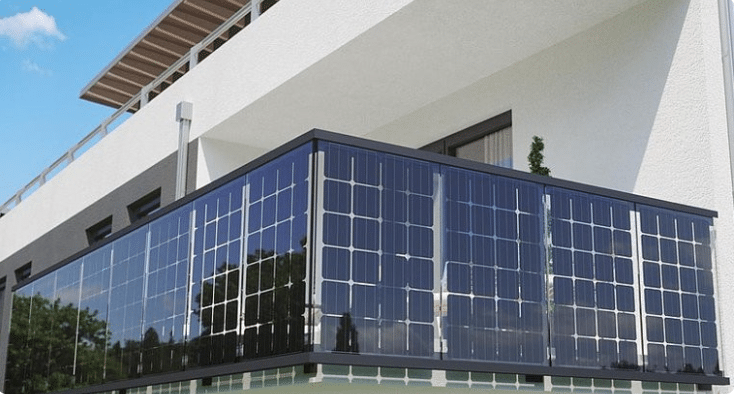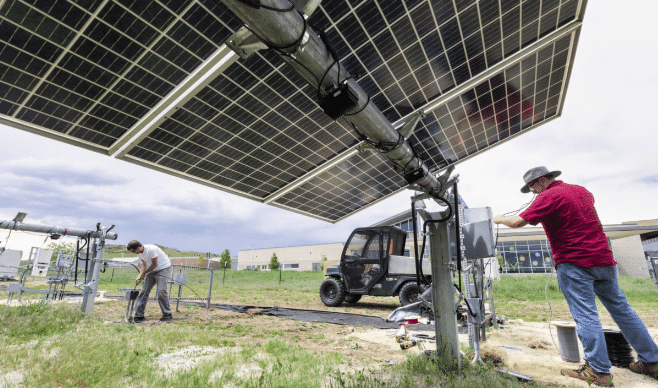It is well known that bifacial solar panels offer many advantages over conventional solar panels. Bifacial modules generate electricity on both sides of the module, thus increasing the total power generation. Bifacial modules are generally more durable because they are both UV resistant and potential induced degradation (PID) problems are reduced when the bifacial module is frameless. Balance of System (BOS) costs are also reduced when bifacial modules generate more power in a smaller array footprint.
Table of Contents
What are bifacial solar panels?
Conventional (single-sided) solar panels capture sunlight on the side that absorbs the light; any light energy that cannot be captured will be reflected away. A bifacial solar panel is a solar energy device specifically designed to utilize solar energy from both its front and back sides. In contrast to standard single-sided solar panels, which are equipped with photovoltaic cells on one side only, bifacial panels are equipped with these cells on both sides. This allows them to generate electricity from light hitting them from either direction.
Also because double-sided modules are designed to collect sunlight from both sides, they usually rise from the surface. This means they are less likely to overheat. Double sided modules come in a variety of designs. Some are framed and some are frameless. Some are double-glazed, while others use a transparent backsheet. Most use monocrystalline cells, but there are also polycrystalline designs. The one thing that doesn’t change is that power is generated from both sides. Some frameless double-glass modules expose the back of the cell, but are not bifacial. True bifacial modules have contacts/bushes on both the front and back of their cells. Of course, usually bifacial solar panels involve double or parallel, can be understood in detail:Solar Panels Series Vs Parallel

Bifacial solar panels types?
There are three main types of bifacial solar panel panels
1, glass/glass: these bifacial solar panels have glass surfaces on both sides, making their structure more robust and able to withstand loads better than other types of bifacial solar panels or single-sided solar panels
2、Glass/Transparent backsheet: The front side is wrapped in glass and the back side is protected by a transparent backsheet. Usually cheaper than glass/glass panels
3、Glass/Backsheet:Similar to its bifacial counterpart, with glass on the front and an opaque backsheet on the back.
Why TOPCon is the best choice for bifacial solar panels
Latest Module Trends Expect Market Growth to Focus on HJT and TOPCon Solar Cells. The International Technology Roadmap for Photovoltaics (ITRPV) 2022 report shows some of the expected trends over the next 10 years:
❖ PERC (passivated emitter rear contact) solar cell technology is currently the market leader with a market share of around 75%. However, the share of p-type monocrystalline PERC cells is expected to decline to around 10 per cent over the next 10 years.
❖ N-type TOPCon (Tunneling Oxide Passivated Contact) technology will increase its market share from about 10 per cent in 2022 to 60 per cent in 2033, becoming the dominant wafer type. The largest increase is expected to start in 2024.
❖ N-Type HJT (Heterojunction Solar Cells) is expected to increase from ~9% (2023) to more than 25% over the next decade. Implementation of heterojunction cell technology is still facing difficulties due to high production costs of solar cells and incompatibility of production lines with existing technologies.
Higher efficiency: The efficiency can exceed 25%, and the maximum theoretical efficiency of PERC cells is 24%
Lower temperature coefficient: The temperature coefficient is -0.32%/, which has better resistance to extreme weather
Higher bifacial efficiency: The bifacial coefficient is as high as 85%, which collects more energy from the back compared to PERC bifacial modules.
High bifaciality: Greater efficiency in low-light conditions, extending power generation during the day and improving the performance of the installation over time
Of course: PID also affects the average life expectancy of bifacial solar panels
, this point is also particularly important
The scientists also compared the levelized cost of energy (LCOE) for 5MW ground-mounted PV plants relying on bifacial PERC technology and TOPCon products featuring LPCVD, PECVD and APCVD. Their analysis showed that the TOPCon techs have 13.5–18.6% higher All-in Cell costs and 3.6–5.5% higher All-in Module costs in comparison to PERC benchmark.
Advantages and Disadvantages of Bifacial Solar Panels
advantage | Disadvantages |
Improve efficiency | Higher production costs |
climate adaptability | heavier |
Improve system capacity factor | Installation is not very flexible |
Maximize land use and increase efficiency | Not suitable for installation on dark, non-reflective surfaces |
beautiful | Installation costs are higher |
Duty exemption for bifacial solar panels
Tariffs on solar panels and equipment have impacted the industry over the past few years. Beginning in 2018, President Trump imposed tariffs on solar panels that are not domestically produced. These tariffs are designed to spur growth in the U.S. solar manufacturing and production industry – which limits access to cheaper solar panels.
Since assuming the presidency, the Biden administration has maintained these tariffs and decided to extend them for another four years in 2022. However, they made a key decision by choosing to exempt bifacial solar panels. This is important for consumers because it allows you to get cheaper panels, and bifacial solar panels are once again exempt from the 201 tariffs!
What installation scenarios are suitable for double-sided solar panels?
Balcony solar panels:
Bifacial balcony solar panels are now more and more widely used on balconies. With the limited roof area, maximizing the use of balconies or gardens can be regarded as a way to maximize energy benefits. As long as your balcony faces south, you can build this “balcony power plant” ”, of course, this also applies to balconies facing southwest or southeast. The size of the system determines performance and ultimately cost, with the amount of electricity generated depending on the number and power levels of solar panels installed.
“Plug and play solar panels can be installed in a variety of ways, depending on the latitude of the location, the tilt angle of the panels, and the load-bearing capacity of the balcony. A common wall-mounted version is to tilt the panels parallel to the wall, or they can be mounted using wheeled racks Place directly in the middle of the balcony or install as a suspended canopy.

Large ground-mounted bifacial solar panels:
Bifacial solar panels demonstrate superior performance in large ground-mounted photovoltaic plants. They excel at utilising sunlight reflected from the ground, especially in areas of high ground reflectivity such as sand or white mulch. This feature allows large ground-mounted solar panels to collect sunlight more efficiently, thereby increasing overall energy production.
Commercial Roofing Systems:
For commercial buildings with plenty of roof space, bifacial solar panels are an excellent choice. They are particularly good at maximising the use of sunlight reflected from the roof surface, especially if the roofing material is highly reflective. The use of bifacial solar panels in a commercial roofing system can significantly increase the energy harvesting efficiency of the solar panels. This setup not only improves energy efficiency, but also provides a sustainable energy solution for commercial buildings.
Parking lot awnings:
Installing a double-sided solar panel on a car park awning serves a dual purpose. Not only does it provide the necessary shade for vehicles, but it also utilises sunlight from both the top and bottom surfaces. This innovative approach not only improves the environmental quality of the car park, but also increases energy efficiency. In addition, it promotes a sustainable energy supply, effectively turning a standard car park into a green power generation space.
Agricultural photovoltaics:
The use of bifacial solar panels goes beyond the energy sector, combining effectively with agriculture to create agricultural photovoltaic systems. When installed over agricultural land, these panels promote dual use of the land: agriculture and photovoltaic power generation. Crops growing beneath the solar panels benefit from the sunlight that passes through, while the panels themselves capture the reflected sunlight. This setup represents an efficient use of resources, harmonising solar production with agricultural practices.

Are bifacial solar panels worth it?
Bifacial solar panels are worth it. There are also solar cells on the back, which can increase the amount of power you get by collecting sunlight reflected from surrounding surfaces.
You can maximize the output of bifacial modules by mounting them on a solar tracking system so that they are always tilted toward the sun.
However, they are currently not suitable for residential use. The tall mount makes installation on suburban rooftops and backyards inconvenient. Additionally, home solar systems struggle to cover the higher upfront costs even in the long run.
If you are looking for home solar panels, high-quality single-sided monocrystalline solar panels are still your best choice.

























